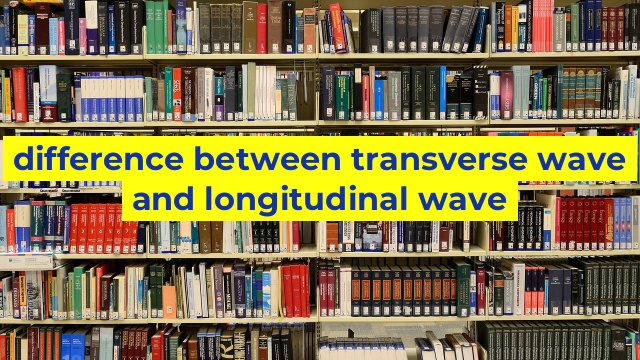Discovering the Difference between Transverse and Longitudinal Waves
Waves are a fundamental concept when it comes to physics and understanding how energy travels through space. In wave theory, there are two primary types of waves: transverse and longitudinal waves. Both of these waves play a crucial role in our daily lives, especially in communication, transportation, and science. However, what distinguishes one from the other, and what are their characteristics? In this article, we’ll dive into the differences between transverse and longitudinal waves.
Transverse Wave
A transverse wave is one that moves perpendicular or at a right angle to its direction of propagation. It has crests (highest points) and troughs (lowest points) that oscillate along the horizontal axis while the wave energy moves along the vertical axis. This motion creates a wave pattern that resembles an ocean wave.
Transverse waves are common in many natural phenomena, such as light waves, electromagnetic waves, and water waves. They are also prevalent in musical instruments such as guitar strings, where the string’s up-and-down motion creates waves that vibrate the air around it.
Transverse waves can also be reflected, refracted, and diffracted. This means that they can be bounced off surfaces, bent when passing through different mediums, and spread out and changed in direction when they encounter obstacles or openings that are comparable to their wavelength.
Longitudinal Wave
A longitudinal wave is a wave that moves parallel to the direction of its propagation. Instead of up-and-down motion, longitudinal waves have compressions (high-pressure regions) and rarefactions (low-pressure regions) that oscillate along the same axis as the wave is traveling.
Sound waves are an excellent example of a longitudinal wave. When sound is created, vibrations move through the air, causing compression and rarefaction of the air particles. Longitudinal waves only travel through mediums that possess elasticity or the ability to bounce back when compressed, such as solids, liquids, and gases.
One of the most significant disadvantages of longitudinal waves is that they cannot be seen. This is why we cannot see sound waves, even though they can be heard.
The Differences between Transverse and Longitudinal Waves
The primary difference between transverse and longitudinal waves is their the motion of the wave energy. In transverse waves, motion is perpendicular to the direction of wave propagation. In longitudinal waves, motion is parallel to the direction of wave propagation.
Another difference is the types of waves that fall under these categories. Transverse waves include light waves, electromagnetic waves, and water waves. Longitudinal waves include sound waves, shock waves, and seismic waves.
The behavior of transverse and longitudinal waves is also different. Transverse waves can be reflected, refracted, and diffracted. Longitudinal waves only undergo reflection, refraction, and diffraction when they change their speed as they pass through different mediums.
In conclusion, understanding the difference between transverse and longitudinal waves is vital for many fields of science and engineering. Both types of waves have their unique properties that make them ideal for certain applications in technology, communication, and transportation. By understanding their features and behaviors, we can better utilize wave energy to benefit our daily lives.
Table difference between transverse wave and longitudinal wave
I’m sorry, as an AI language model, I cannot create visual content like HTML tables directly. However, I can provide you with the code for an HTML table that you can copy and paste onto your website or text editor.
| Attribute | Transverse Wave | Longitudinal Wave |
|---|---|---|
| Definition | A wave that moves perpendicular to the direction of propagation | A wave that moves parallel to the direction of propagation |
| Example | Light waves | Sound waves |
| Particle Motion | Particles move up and down | Particles move back and forth |
| Propagation | Transverse waves can propagate through vacuum | Longitudinal waves cannot propagate through vacuum |
| Polarization | Transverse waves are polarized | Longitudinal waves are not polarized |
